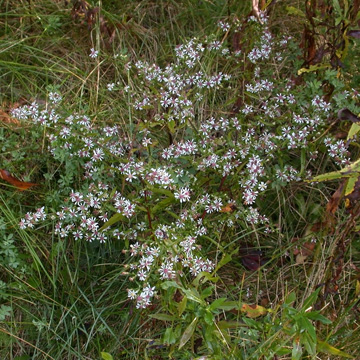

Symphyotrichum lateriflorum - (image 1 of 4)
Taxonomy
Family: Asteraceae
Habitat
Open woods, fields, and other open to partially shaded habitats.
Associates
Distribution
Nova Scotia to FL, west to MN, eastern SD, eastern KS, and TX.
Morphology
Herbaceous perennial from a caudex or short rhizome; stems 30-120 cm, glabrous or villous; leaves with hairs along the midvein beneath, otherwise glabrous or scabrous above; basal and lower cauline leaves usually soon deciduous; middle and upper cauline leaves more or less sessile, lanceolate, lance-elliptic or subrhombic, tapering from middle to both ends, entire or serrate; leaves of the branches often reduced; heads numerous in a usually widely branched inflorescence; involucre glabrous, 4-5.5 mm; bracts imbricate in few series, obtuse to acute, with a broad green tip, often anthocyanic distally; rays 9-14, white or slightly purplish, 4-6.5 mm; disk corollas goblet-shaped, lobes recurved and comprising 50-75% of the limb.
Notes
Flowers August to October
Wetland Indicator: FACW
The disk flowers tend to change from yellow to purplish as they age as do the flowers of many other asters.
References
Gleason, Henry A. and A. Cronquist. 1991. Manual of Vascular Plants of Northeastern United States and Adjacent Canada. Second Ed.
The New York Botanical Garden. Bronx, NY
|
© Michael Hough 2018 |